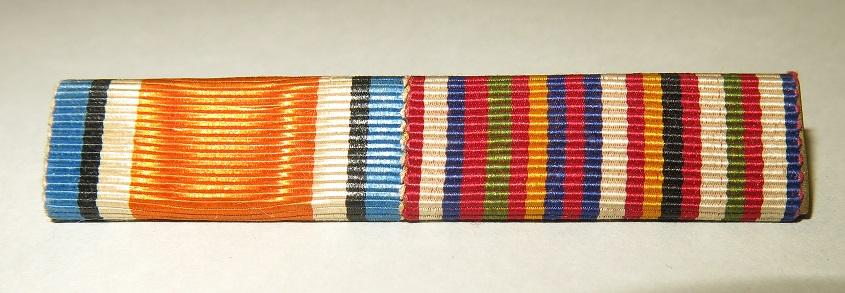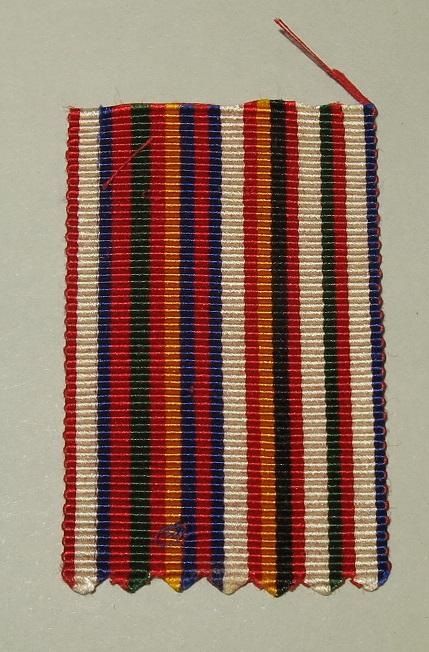The unofficial Victory Medal ribbon of 1919
One item we get regular enquiries about is a strange multi-coloured ribbon found on the end of some old medal ribbon bars. This ribbon, made up of many coloured stripes is an unofficial ribbon for the Victory Medal from early-mid 1919.
In January 1919 some of the Allied nations suggested that there should be a single medal created for all allied and associated countries, so that there would be no need for the exchange of commemorative medals between the victorious nations.

Medal ribbon bar featuring the British War Medal 1914-20 ribbon and the unofficial Victory Medal ribbon.
In March 1919 a conference of Allied and Associated Powers met to discuss medals and the first question they looked at was the idea for an “Inter-Allied Medal”. After much debate, the result was the Victory Medal (so called because they wanted a name that the Germans and their allies could not use). The new medal was to have the same ribbon, regardless of country and an image representing victory on the obverse.
Before the official ribbon was approved a number of commercial companies created their own versions of what they thought the Victory Medal ribbon could look like. These unofficial ribbons often combined the flags, or colours from the flags of many of the victorious nations.
An unusual enamelled version of a ribbon bar with the unofficial Victory Medal ribbon

Sample of unofficial Victory Medal ribbon purchased in London in 1919.
Small lengths of the unofficial ribbon were sold for mounting on medal ribbon bars so they could be worn while the men waited for their medals to be issued – most Australians received their Victory Medals between 1921 and 1923, but pieces of the official ribbon were available after its approval and so most medal ribbon bars will have a piece of the official silk ribbon rather than this unofficial ribbon.
Victory Medal with original watered silk rainbow ribbon. Awarded to 53377 Acting Corporal Francis Burchill who served with 9 Battalion.
As to the official ribbon, many proposals were put forward and the American representative even brought a large number of examples of ribbons to the conference. The British representative pointed out the conference was too large to make a decision on the ribbon and proposed the selection be left to the French representative, which was eventually agreed to. The French representative said the only way a coloured ribbon could be produced that could please everyone was to use the rainbow as it had all colours. The British objected as the 1914-15 Star (with a watered silk red, white and blue ribbon) was already “rainbow like”. The French representative understood the concern so suggested a double rainbow which was agreed to by all representatives.
Victory Medal with modern rainbow ribbon. Awarded to 3849 Corporal (Cpl) Frank McArthur who served with 13 Battalion.
For a more detailed (and rather amusing) account of the creation of the Victory Medal, see “The Allied Victory Medal” by Brigadier Stuart Ryder, published in Medal News, September 1998.


